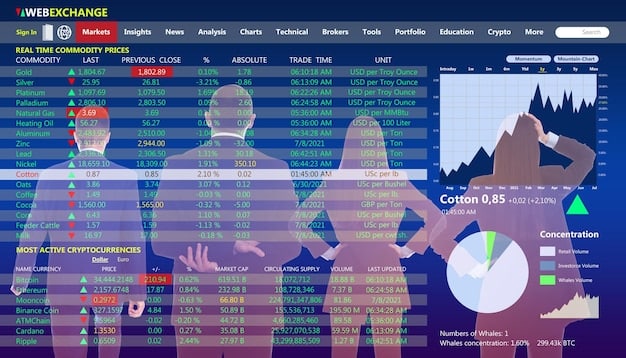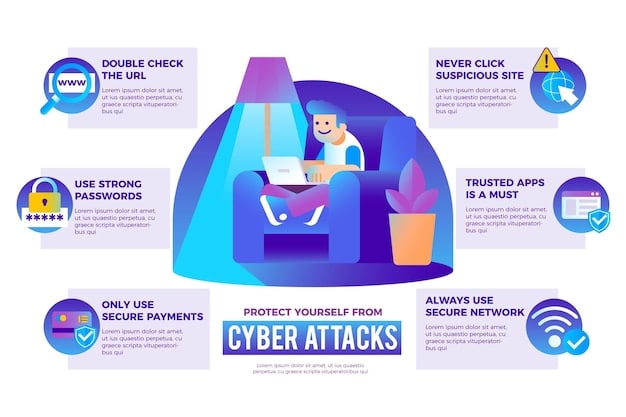DeFi Lending Platforms: Comparing Rates and Security for US Users

DeFi lending platforms offer US users opportunities to earn or borrow cryptocurrency, but it’s essential to compare interest rates and security measures across platforms to make informed decisions.
Decentralized Finance (DeFi) is revolutionizing the way we interact with financial services, especially in the US. Among the most popular DeFi applications are DeFi lending platforms: Comparing Interest Rates and Security for US Users before diving in is crucial to navigating this landscape safely.
Understanding DeFi Lending Platforms for US Users
DeFi lending platforms have emerged as a compelling alternative to traditional financial institutions, offering both borrowers and lenders unique opportunities. For US users specifically, understanding how these platforms operate and the potential benefits they offer is critical.
These platforms leverage blockchain technology to create a peer-to-peer lending ecosystem, eliminating intermediaries and potentially offering more favorable interest rates. However, this also means users need to be aware of the associated risks, including smart contract vulnerabilities and the volatility of cryptocurrencies.

How DeFi Lending Works
DeFi lending platforms connect lenders and borrowers directly through smart contracts, which are self-executing agreements written in code. Here’s a breakdown:
- Lenders: Deposit their cryptocurrency into a lending pool, earning interest on their holdings.
- Borrowers: Collateralize their loans by depositing cryptocurrency as security and borrow other assets.
- Smart Contracts: Automatically manage the lending and borrowing process, including interest rate calculations and collateral liquidation.
Benefits for US Users
For US users, DeFi lending platforms offer several potential advantages:
- Higher Interest Rates: Lenders can potentially earn higher interest rates compared to traditional savings accounts or CDs.
- Access to Borrowing: Borrowers can access loans without credit checks, using their cryptocurrency holdings as collateral.
- Transparency and Control: DeFi platforms are transparent, with all transactions recorded on the blockchain, giving users more control over their funds.
In conclusion, DeFi lending platforms present a new frontier in finance, offering potential benefits for US users. However, it is essential to understand the underlying technology, risks, and security considerations before participating.
Comparing Interest Rates Across DeFi Platforms
One of the primary factors attracting users to DeFi lending platforms is the potential for higher interest rates. However, these rates can vary significantly across different platforms and even within the same platform for different cryptocurrencies. Understanding these variations is crucial for maximizing returns.
Interest rates in DeFi are influenced by supply and demand, the perceived risk of the underlying assets, and the platform’s governance mechanisms. Let’s delve into strategies for comparing interest rates effectively.
Factors Affecting Interest Rates
Several factors influence the interest rates on DeFi lending platforms:
- Supply and Demand: If there’s high demand to borrow a specific cryptocurrency and limited supply, interest rates will likely be higher.
- Asset Volatility: More volatile assets typically have higher interest rates to compensate lenders for the increased risk.
- Platform Governance: Some platforms use governance tokens to incentivize participation, which can impact interest rates.
Tools and Strategies for Comparison
To effectively compare interest rates across platforms, consider using these tools and strategies:
- DeFi Rate Aggregators: Websites that aggregate interest rates from various DeFi lending platforms, making it easier to compare options.
- Yield Farming Calculators: Tools that help estimate the potential returns from different lending strategies, considering factors like gas fees and impermanent loss.
- Platform Documentation: Review the platform’s documentation to understand how interest rates are calculated and any associated risks.
Comparing interest rates across DeFi platforms requires a thorough understanding of the underlying factors and the use of specialized tools. By carefully evaluating these elements, US users can make informed decisions and optimize their returns while managing risk effectively.
Assessing Security Risks in DeFi Lending
Security is paramount when participating in DeFi lending. While DeFi platforms offer exciting opportunities, they also come with inherent risks. Understanding and mitigating these risks is essential for protecting your assets.
Common security risks include smart contract vulnerabilities, rug pulls, and impermanent loss. Let’s explore these risks and how to assess them effectively.
Common Security Vulnerabilities
DeFi lending platforms are susceptible to several security vulnerabilities:
- Smart Contract Bugs: Flaws in the code governing the platform can be exploited by hackers, leading to fund losses.
- Rug Pulls: Malicious actors create a lending platform, attract users, and then abscond with the deposited funds.
- Impermanent Loss: A risk associated with providing liquidity to decentralized exchanges, where the value of deposited assets can fluctuate, leading to losses.
Evaluating Platform Security Measures
To assess the security of a DeFi lending platform, consider the following:
- Audits: Look for platforms that have undergone rigorous security audits by reputable firms.
- Insurance: Some platforms offer insurance coverage against smart contract exploits or other risks.
- Community Reputation: Research the platform’s reputation within the DeFi community and look for any red flags or past incidents.
Evaluating the security risks in DeFi lending requires vigilance and due diligence. By understanding common vulnerabilities and assessing platform security measures, US users can protect their investments and participate in DeFi with greater confidence.

Regulatory Landscape in the US for DeFi Lending
The regulatory landscape for DeFi lending in the US is still evolving and remains somewhat uncertain. Understanding the current regulations and potential future developments is critical for US users.
The Securities and Exchange Commission (SEC) and other regulatory bodies are closely monitoring the DeFi space, and new regulations could significantly impact the operation and accessibility of DeFi lending platforms. Staying informed and compliant is essential.
Current Regulations and Guidelines
Here’s an overview of the current regulatory environment:
- Securities Laws: The SEC may consider some DeFi tokens as securities, subjecting them to registration and compliance requirements.
- Money Laundering Regulations: DeFi platforms must comply with anti-money laundering (AML) and know-your-customer (KYC) regulations.
- Tax Implications: US users must report their DeFi lending activities and pay taxes on any earned interest or profits.
Future Regulatory Developments
Looking ahead, several regulatory developments could impact DeFi lending:
- Increased Scrutiny: Regulators may increase their scrutiny of DeFi platforms, leading to stricter enforcement actions.
- New Legislation: Congress could pass new legislation specifically addressing DeFi lending and other crypto-related activities.
- International Coordination: Global regulatory bodies may coordinate their efforts to regulate DeFi on an international level.
Navigating the regulatory landscape in the US for DeFi lending requires staying informed and adapting to changing rules. By understanding current regulations and anticipating future developments, US users can participate in DeFi responsibly and legally.
Strategies for Maximizing Returns and Minimizing Risks
Successfully navigating DeFi lending involves not only understanding the platforms and risks, but also employing effective strategies to maximize returns and minimize potential losses. Implementing a diversified approach and continuously monitoring your investments is key.
Here, we examine several strategies US users can deploy to optimize their DeFi lending experience.
Diversification and Risk Management
Diversification is a core principle in risk management:
- Spread Your Assets: Don’t put all your cryptocurrency into one lending platform. Diversify across multiple platforms to reduce the impact of any single failure.
- Choose Different Assets: Lend and borrow a variety of cryptocurrencies to mitigate the risk of any single asset’s volatility.
- Use Stop-Loss Orders: Implement stop-loss orders to automatically sell your assets if they reach a certain price, limiting potential losses.
Yield Farming and Staking Strategies
Yield farming and staking can enhance your returns:
- Explore Yield Farming Opportunities: Participate in yield farming programs that offer high rewards for providing liquidity.
- Stake Your Tokens: Stake your tokens to earn additional interest and participate in platform governance.
- Monitor Your Investments: Continuously monitor your investments and adjust your strategies as market conditions change.
Combining diversification, risk management, and strategic yield farming can significantly enhance your DeFi lending experience. By implementing these strategies, US users can maximize their returns while minimizing potential risks.
Comparing Popular DeFi Lending Platforms: A US User Perspective
Several DeFi lending platforms are popular among US users, each with its own strengths and weaknesses. Comparing these platforms based on interest rates, security measures, and user experience is crucial for making an informed decision.
Platforms like Aave, Compound, and MakerDAO are widely used, but it is essential to understand what each offers from a US user’s point of view.
Aave
Aave is a decentralized lending protocol allowing users to lend and borrow a wide range of cryptocurrencies. Its features include:
- Flash Loans: Uncollateralized loans that must be repaid within the same transaction block.
- Variable and Stable Interest Rates: Offers both variable and stable interest rates to suit different risk appetites.
- Governance Token (AAVE): Allows token holders to participate in governance decisions.
Compound
Compound is another popular DeFi lending platform known for its simplicity and ease of use. Key features include:
- Automated Interest Rate Adjustments: Interest rates are automatically adjusted based on supply and demand.
- cTokens: Represents deposited assets and earn interest in real-time.
- Governance Token (COMP): Enables community governance of the protocol.
MakerDAO
MakerDAO is unique in that it focuses on the creation of DAI, a stablecoin pegged to the US dollar. Main features include:
- DAI Stablecoin: Users can borrow DAI by collateralizing other cryptocurrencies.
- Stability Fee: A variable interest rate charged on DAI loans.
- Governance Token (MKR): Used to govern the MakerDAO protocol and manage the stability of DAI.
By comparing these popular DeFi lending platforms based on their features, interest rates, and security measures, US users can choose the platform that best aligns with their financial goals and risk tolerance.
| Key Aspect | Brief Description |
|---|---|
| 💰 Interest Rates | Vary significantly; compare rates on different platforms. |
| 🔒 Security Risks | Include smart contract bugs and potential rug pulls. |
| ⚖️ Regulations | Evolving regulatory landscape in the US requires monitoring. |
| 🛡️ Risk Management | Diversify assets and use stop-loss orders. |
FAQ: DeFi Lending Platforms in the US
▼
DeFi lending platforms offer potentially higher interest rates compared to traditional savings and provide access to borrowing without credit checks. They also promote transparency by recording transactions on the blockchain.
▼
Use DeFi rate aggregators to compare interest rates from various DeFi lending platforms. Also, review platform documentation to understand how interest rates are calculated and the associated risks.
▼
Be aware of smart contract bugs, rug pulls, and impermanent loss. Evaluate platforms based on audits, insurance coverage, and community reputation to mitigate these risks.
▼
The regulatory landscape is evolving, with the SEC and other bodies monitoring the space. Ensure compliance with securities laws, anti-money laundering regulations, and tax implications related to DeFi activities.
▼
Diversify your assets across multiple platforms and cryptocurrencies. Implement stop-loss orders to limit potential losses and explore yield farming and staking opportunities to enhance your returns while minoring risks.
Conclusion
In conclusion, navigating the world of DeFi lending platforms: Comparing Interest Rates and Security for US Users involves carefully balancing potential gains with inherent risks. By understanding the nuances of interest rates, security vulnerabilities, and regulatory guidelines, US users can make informed decisions that align with their financial goals and risk tolerance, maximizing opportunities while minimizing potential drawbacks.





